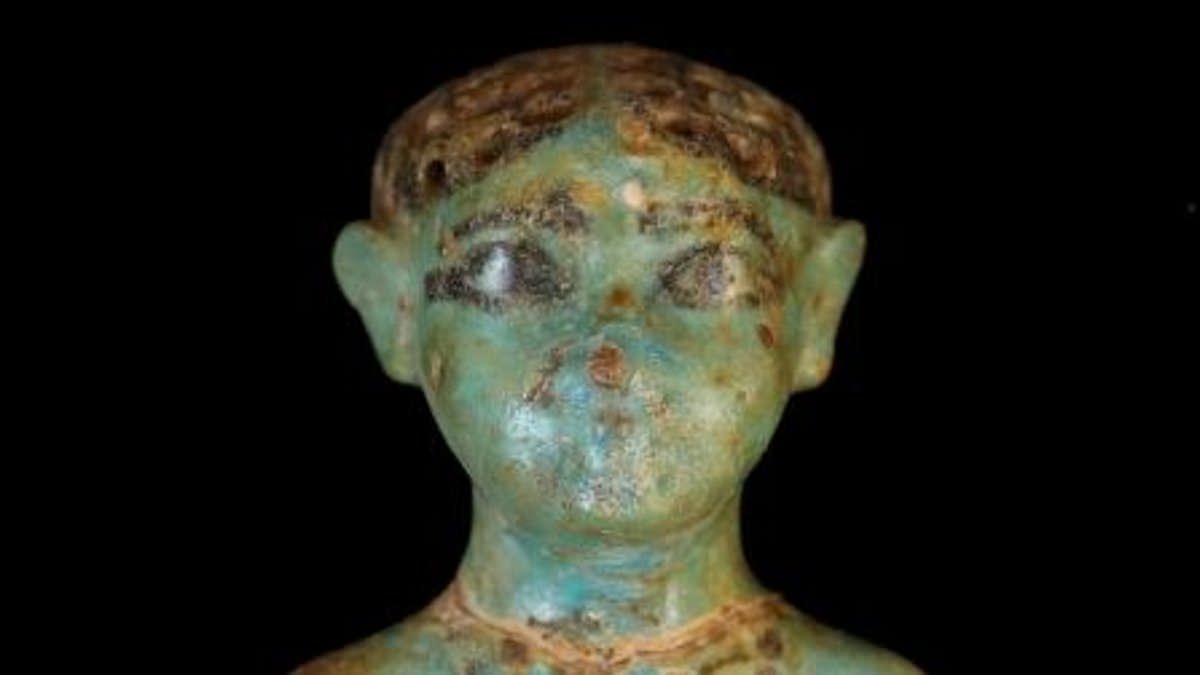Archaeologists have unearthed an first-of-its-kind ancient Egyptian tomb that dates back nearly 4,000 years.
The burial chamber contained the remains of 11 men, women and children, suggesting it was a family cemetery used for generations during the 12th and 13th Dynasty.
The find marks the first Middle Kingdom tomb that has been discovered in the area, which ranged from 1938 BC to 1630 BC.
American and Egyptian researchers with the South Asasif Conservation Project noted that the bodies were lain side-by-side in wooden coffins, with their heads facing in alternating directions.
Although ancient floods had destroyed the wooden coffins and their linen wrappings, researchers found that items like figurines and jewelry – including a necklace and hippo-head amulet – were still intact.
Among the treasures were two copper mirrors, one had a lotus-shaped handle while the other had a design of Hathor – the Egyptian goddess of the sky, women, fertility and love.
The tomb was discovered next to the Temple of Hatshepsut on the west bank of the Nile River in Luxor.
Katherine Blakeney, the lead American archaeologist, said: ‘The unearthing of the first Middle Kingdom tomb in the South Asasif necropolis alters its history, placing South Asasif within the sprawling Theban Middle Kingdom necropolis.’


Researchers plan to continue excavations to find other artifacts that could shed light on how people lived during the Middle Kingdom in Egypt

The artifacts included a beaded necklace made of amethyst that was discovered while the archaeologists conducted restoration efforts of the tomb of Karabaskin, a 25th Dynasty official
The researchers identified skeletons belonging to five women, two men and three children, with the final family member’s gender and age still unknown.
The discovery was made during restoration efforts of the tomb of Karabaskin, a 25th Dynasty mayor of Thebes and the fourth priest of Amun, according to the Egyptian Ministry of Tourism and Antiquities (MTA).
Archaeologists said that the find has altered the South Asasif’s history, which was previously believed to only contain burials from the 18th, 22nd, 25th and 26th dynasties of ancient Egypt, ranging from 1550 BC to 525 BC.
The graves likely date back to the top 12 families in the region, the MTA said, adding that the find could contribute to archaeologist’s understanding of the burial practices and rituals at the time.
The majority of the jewelry was found among the female’s remains with the exception of an exquisite necklace that was discovered in one of the men’s tombs.
This was perhaps the most prominent of the discoveries because the necklace, which consisted of 30 amethyst beads and two beads of agate surrounding the head of a hippopotamus, indicated the man held a high station.
During the Theban Middle Kingdom, the hippopotamus was considered of utmost importance because it represented the Nile River’s power and was often buried in tombs to protect the deceased as they entered the afterlife.
Figurines of hippos were commonly found in Middle Kingdom tombs and was sometimes depicted as the pregnant goddess Taweret which signified fertility and protection.

This necklace was considered to be the most important because it was the only one belonging to a man and may have signified that he was of a higher station

Archaeologists found necklaces, bracelets and other artifacts that primarily belonged to women in the tomb
The animal also decorated necklaces, bracelets, rings and belts made of red agate that were still in good condition when the tomb was opened.
‘Such craftsmanship underscores the cultural and artistic sophistication of the Middle Kingdom,’ Blakeney told Archaeology Magazine.
Egyptians who lived during the Middle Kingdom experienced a period of prosperity and political stability.
Read More
'Overlooked' clue on Tutankhamun's death mask that could re-define the boy-king's death

After decades of disarray, they built a strong centralized government and had a thriving trade and successful agriculture that led to an abundance in food production and a thriving economy.
Pharaohs in the 12th Dynasty were considered to be ‘good shepherds’ who actively cared for their people and members of the middle class saw their lives improve as they gained access to more consumer goods.
The Middle Kingdom is believed to have peaked during this time when pharaohs Amenemhet I and Senusret I boosted the people’s prosperity, cultural, artistic and literary achievements.
The American team said it is now planning to conduct additional excavations in the area to reveal more aspects of the ancient tomb and shed light on how its inhabitants lived during the Middle Kingdom era.
